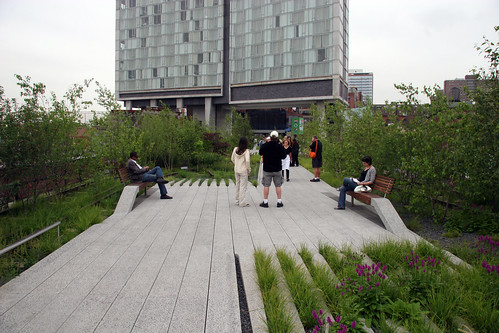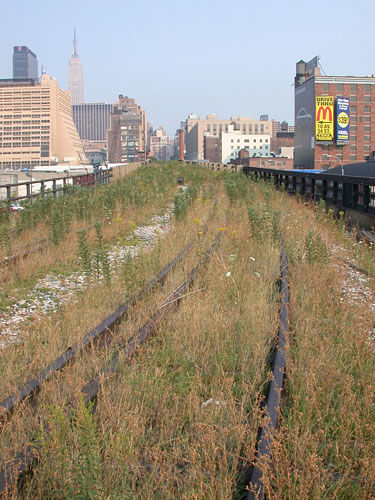The High Line in 2009
The High Line, which I wrote about at the end of 2007, opened to the public this week as a newly-landscaped public park. It looks pretty great:
But it's interesting how the context of the High Line has changed since its current incarnation went under construction two years ago. Back then, Manhattan was in the middle of a real estate boom for the ultra-wealthy. The overgrown High Line was a romantic idiosyncrasy - a few acres of overgrown, abandoned meadowland that held itself aloof from the city's real estate obsessions.
The High Line was initially pitched as a new park by a few activists who wanted to preserve this beautiful bit of wilderness in their neighborhood. Here's what it looked like back then:
The idea may have come from the grassroots, but the High Line became a reality at the hands of developers and politicians who wanted an amenity for the wealthier, less wild neighborhood they envisioned in place of the industry and empty lots of the old Meatpacking District.
Construction began near ground zero of the real estate boom. Workers scraped away all of the High Line's wild growth and replaced it with new soil beds and plantings according to architectural plans designed to mimic the abandoned landscapes they were replacing. Meanwhile, a new forest of ultra-luxe high rises began to rise in the surrounding neighborhood, fertilized by the new high-concept park.
Then, of course, the housing market fell to earth - which, for Manhattan's real-estate space cadets, was a very, very long way to fall. Suddenly, the old High Line's overgrown abandonment wasn't a such a novelty: we began seeing the same triumphs of nature in suburban backyards and half-finished construction sites all over the country.
They're still building new high-rises around the newly-opened High Line, but it's a lot less certain, now, about who's going to pay millions of dollars to live in the skyscraper with the car elevator (it lets lucky residents park their cars on the same floor where they sleep*).
In the new economy, the High Line feels a lot weirder. It was meant to be a futuristic preserve for New York's past - especially its overgrown lots and abandoned industrial infrastructure. Now that the park is open, though, the ultra-slick High Line feels a bit out of place. Instead of evoking New York City's past, the High Line looks more like an expensive simulation of conditions in inner-city Detroit, or of a foreclosed backyard, or of any of the thousands of newly-defunct car dealerships nationwide. Those conditions were rare in New York City two years ago, but now that they're fairly commonplace in society's consciousness, the High Line seems more artificial and contrived.
This sounds harsher than I mean it too: lots of park landscapes are artificial and contrived, and also successful. I'm actually very much looking forward to visiting this new park, and I'm excited that so many New Yorkers had the vision to recognize and preserve this bit of wilderness in the middle of the city.
My point is that even though every sapling, rusted rail, and clump of wildflowers is in its place according to the architectural plans, the High Line Park that opened this week is quite different from the High Line Park that was designed two or three years ago. Our experiences in society shape our experiences of nature, and society is changing a lot right now.
I hope that there will be many more parks like the High Line, and I expect that one of many silver linings of this recession is that there will be. What better place to think about our society's changing relationships with nature than on an overgrown ruin of the old economy?
* Re: the car-elevator condo: I don't understand how people willing to pay for a drive-in elevator - in order to minimize their exposure to public places - are expected to benefit from their proximity to a park like the High Line. It seems as though they'd be just as happy - if not happier - living next to a heavily-guarded prison. Or in one: after all, in the real estate market for multi-billionaire captains of finance, prison cells are probably one of the fastest-growing segments.
But it's interesting how the context of the High Line has changed since its current incarnation went under construction two years ago. Back then, Manhattan was in the middle of a real estate boom for the ultra-wealthy. The overgrown High Line was a romantic idiosyncrasy - a few acres of overgrown, abandoned meadowland that held itself aloof from the city's real estate obsessions.
The High Line was initially pitched as a new park by a few activists who wanted to preserve this beautiful bit of wilderness in their neighborhood. Here's what it looked like back then:
The idea may have come from the grassroots, but the High Line became a reality at the hands of developers and politicians who wanted an amenity for the wealthier, less wild neighborhood they envisioned in place of the industry and empty lots of the old Meatpacking District.
Construction began near ground zero of the real estate boom. Workers scraped away all of the High Line's wild growth and replaced it with new soil beds and plantings according to architectural plans designed to mimic the abandoned landscapes they were replacing. Meanwhile, a new forest of ultra-luxe high rises began to rise in the surrounding neighborhood, fertilized by the new high-concept park.
Then, of course, the housing market fell to earth - which, for Manhattan's real-estate space cadets, was a very, very long way to fall. Suddenly, the old High Line's overgrown abandonment wasn't a such a novelty: we began seeing the same triumphs of nature in suburban backyards and half-finished construction sites all over the country.
They're still building new high-rises around the newly-opened High Line, but it's a lot less certain, now, about who's going to pay millions of dollars to live in the skyscraper with the car elevator (it lets lucky residents park their cars on the same floor where they sleep*).
In the new economy, the High Line feels a lot weirder. It was meant to be a futuristic preserve for New York's past - especially its overgrown lots and abandoned industrial infrastructure. Now that the park is open, though, the ultra-slick High Line feels a bit out of place. Instead of evoking New York City's past, the High Line looks more like an expensive simulation of conditions in inner-city Detroit, or of a foreclosed backyard, or of any of the thousands of newly-defunct car dealerships nationwide. Those conditions were rare in New York City two years ago, but now that they're fairly commonplace in society's consciousness, the High Line seems more artificial and contrived.
This sounds harsher than I mean it too: lots of park landscapes are artificial and contrived, and also successful. I'm actually very much looking forward to visiting this new park, and I'm excited that so many New Yorkers had the vision to recognize and preserve this bit of wilderness in the middle of the city.
My point is that even though every sapling, rusted rail, and clump of wildflowers is in its place according to the architectural plans, the High Line Park that opened this week is quite different from the High Line Park that was designed two or three years ago. Our experiences in society shape our experiences of nature, and society is changing a lot right now.
I hope that there will be many more parks like the High Line, and I expect that one of many silver linings of this recession is that there will be. What better place to think about our society's changing relationships with nature than on an overgrown ruin of the old economy?
* Re: the car-elevator condo: I don't understand how people willing to pay for a drive-in elevator - in order to minimize their exposure to public places - are expected to benefit from their proximity to a park like the High Line. It seems as though they'd be just as happy - if not happier - living next to a heavily-guarded prison. Or in one: after all, in the real estate market for multi-billionaire captains of finance, prison cells are probably one of the fastest-growing segments.



 Photo: Jason Levine
Photo: Jason Levine


No comments:
Post a Comment